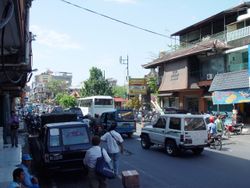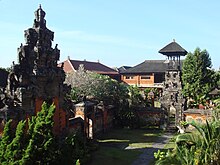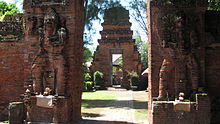Denpasar
| Denpasar | ||
|---|---|---|
|
|
||
| Coordinates | 8 ° 39 ′ S , 115 ° 13 ′ E | |
| Symbols | ||
|
||
|
Motto "PHURADIPA Bhara Bhavana - the capital supporting the country ( Skt. ) " |
||
| Basic data | ||
| Country | Indonesia | |
|
Geographical unit |
Nusa Tenggara | |
| province | Bali | |
| ISO 3166-2 | ID-BA | |
| surface | 124 km² | |
| Residents | 629,588 (2011) | |
| density | 5,078.1 Ew. / km² | |
| Website | www.denpasarkota.go.id | |
|
Gajah Mada Street, Denpasar Barat
|
||
Denpasar (translated as 'central market', also Den Pasar during the colonial days of the Dutch ) is a city in the south of the Indonesian island of Bali . The largest city on the island is also the capital of the province of Bali.
The city's population explosion is remarkable. In 2000 the city had 387,477 inhabitants, who had increased to 637,701 in 2010 due to immigration from Bali and other islands and self-reproduction.
Puputan Square is in the center of the city . He commemorates the ritual mass suicide ( Puputan ) in 1906 by name and with a memorial . The ruling King I Gusti Ngurah Made Agung , along with his court, offered resistance to the Dutch military power who had landed in Sanur and marched on the city , although the futility was a modern one Attacking the army with a few shotguns and the kris that King was well aware of. The Dutch rifle fire and artillery killed almost the entire court and the army, thus fulfilling the prophecy that the king himself had found during his Lontar studies.
Until then, this was the center of the Badung Kingdom . The colonization of the region ended the reign and the city was given a new name. As a trading center, it was now called Denpasar . The imperial temple Pura Jagatnatha from 1432, which was destroyed by Puputan in 1906, was partially rebuilt in 1908. In 2011, an extensive restoration based on old templates was completed.
Denpasar has been separated from the rest of Badung as an urban district since February 27, 1992. The district ( Kabupaten ) Badung borders to the north / south-west. To the east lies the Gianyar district . To Denpasar is one of the traditional seaside resort of Sanur, which at the Balinese for ritual cleanings and closing ceremonies of dead burned ( Ngaben is) in high esteem. There is the temple of Baruna , god of the sea , on the beach .
In addition, the turtle island Serangan with its turtle station and the important temple Pura Sakenan belongs to Denpasar. Before the animals were placed under protection, the consumption of turtle meat was part of practically all important ceremonies in Bali.
Population development
The population in the Denpasar agglomeration grew from 34,000 in 1950 to 924,000 in 2017. 1.3 million inhabitants are expected by 2035.
| year | population |
|---|---|
| 1950 | 34,000 |
| 1960 | 54,000 |
| 1970 | 83,000 |
| 1980 | 131,000 |
| 1990 | 206,000 |
| 2000 | 533,000 |
| 2010 | 792,000 |
| 2017 | 924,000 |
traffic
The road system is strongly structured hierarchically. There are some main roads, e.g. B. the Jalan Gatot Subroto in the north and east or the Jalan Gajah Mada (the name changes several times in the course) in the center. Furthermore, Denpasar is developed with streets like a chessboard, only the rivers, especially the Badung, force some deviations from this pattern. The river valleys are usually deeply cut due to the erosion-prone rock, and bridge heights of over 10 m are more the rule than the exception.
However, only about 40% of the residential buildings can be reached via this road system. The remaining approx. 60% are served via single-lane (partly only 2 m wide) alleys (id. Corridor ) that emanate from them. Unlike many main roads, they can be used in both directions. These alleys open up the squares like a herringbone. They are usually not connected to one another over their entire length.
The main roads are often four or more lane one-way streets with a raised median from the time of oncoming traffic, which repeatedly causes traffic jams at the few changing options.
Typical for the city (as for all of Bali) is the building that extends to the property line. Either, especially in the center or the Islamic districts such as B. Kampung jawa , the building itself or the property wall (in better neighborhoods with larger properties but also around public buildings) delimit the public street space very physically, so that the traffic area is clearly limited. There are sidewalks (mostly on both sides) on streets and main roads and protected from driving by about 30 cm high, alternating black and white curbs.
Denpasar is the transportation hub in Bali. The city is suffocating in constant traffic jams and local public transport only exists in the form of bemos , taxis and intercity buses, which serve three main terminals in Denpasar.
Regulated public transport or rail-bound transport systems do not exist and have never existed. The first public bus line in Bali in terms of local public transport, the Trans Sarbagita (all day 15-minute traffic) Corridor 2 has been running since August 18, 2011 and only affects Denpasar in the southeast. A second line has been running from the center to the airport since summer 2012. Access lines with minibuses are also operated. The number of users has doubled as a result, but there can be no talk of a network effect or even relief of the roads. There is a lack of basics such as B. a through tariff or secure connections. Rather, the conductors in the bus only sell single tickets.
The Ngurah Rai International Airport is located about 12 kilometers, about 30 minutes south of downtown on the isthmus of Nusa Dua in Tuban in Badung.
education
The city has a large number of schools. In addition to general education schools, there is the Art Academy (ISI) and the Dance Academy of Bali (ASTI) at Taman Werdhi Budaya , a park-like art center, where a month-long festival with everything that the visual arts of Bali has to offer takes place every year in June.
The Udayana University has its headquarters in the city. Most of the campus is on Nusa Dua.
The Universitas Mahasaraswati Denpasar , with six faculties, is completely located in downtown Denpasar. In addition to teacher training, the university also offers law , economics , engineering, agronomy and dentistry.
Another university is the Universitas Pendidikan Nasional (UNDIKNAS).
economy
In addition to its role as an administrative center, the city has always been primarily a trading center, as the name suggests. In addition to the three large, traditional markets of Sanglah, Kreneng and Badung, Denpasar also has many specialized shopping streets in which, for example, fabric dealers, jewelers, tangerine dealers and stone dealers are concentrated. There are also around a dozen shopping centers and malls.
With 6.2 million international visitors, Denpasar was the 32nd most visited city in the world in 2017.
Climate table
| Denpasar | ||||||||||||||||||||||||||||||||||||||||||||||||
|---|---|---|---|---|---|---|---|---|---|---|---|---|---|---|---|---|---|---|---|---|---|---|---|---|---|---|---|---|---|---|---|---|---|---|---|---|---|---|---|---|---|---|---|---|---|---|---|---|
| Climate diagram | ||||||||||||||||||||||||||||||||||||||||||||||||
| ||||||||||||||||||||||||||||||||||||||||||||||||
|
Average monthly temperatures and rainfall for Denpasar
Source: wetterkontor.de
|
|||||||||||||||||||||||||||||||||||||||||||||||||||||||||||||||||||||||||||||||||||||||||||||||||||||||||||||||||||||||||||||||||||||||||||||||||||||||||||||||||||||||||||||||||||||||||||||||||||
Architecture and landmarks
The center of Denpasar is the square Taman Puputan , in the middle of which there is an extensive green area with a monument. It commemorates the battle of the rulers of Bali against the Dutch, which took place in 1906 and ended with the ritual suicide ( puputan ) of the ruling house of Badung. Opposite the northwest corner of the square is the red brick town hall of Denpasar on a round square on which a fountain with a monumental, widely visible statue of the god of the four cardinal points, Batara Guru, with four faces and eight arms was built.
On the east side of Taman Puputan, the Negeri Propinsi Bali Museum, the most important museum in Bali, was built in a typical Balinese style in 1910 . It was destroyed in an earthquake in 1917, rebuilt in the 1920s and temporarily used as a warehouse, and it has only been used as a museum again since 1932. The museum area consists of three larger pavilions and is loosened up by green spaces. Several towers can be climbed and offer an impressive panoramic view of the entire complex.
Not far from the museum is the most important temple Denpasar which was built in 1953 and the highest Hindu god Sanghyang Widi consecrated Pura Jagatnatha . His shrine, the walls of which are decorated with representations from the Indian epics Mahabharata and Ramayana , is made of white coral. The shrine was built on a plinth in the shape of a turtle and two reptiles that resemble dragons or snakes - reference is made here to a myth that is still widespread in Bali today , about the creation of the world.
The Roman Catholic Church of St. Joseph ( Gereja Sang Yoseph ) rises in Jalan Kepundung Street near Taman Puputan . It was built in 1936 in the Hindu style and can only be recognized as a church by the white cross on the spire.
In the southeast of the city, a monument to the Balinese's struggle for independence against the Dutch was erected in another park: The Perjuangan Rakyat Bali Monumen is a multi-storey building with exhibition rooms that offers an impressive panoramic view of part of the city. The cultural center Taman Werdi Budaya Art Center with exhibition rooms and an open-air stage is also very popular .
The former royal palace of Denpasar, Puri Pemecutan , burned down in 1906 when Denpasar was taken by the Dutch and was then rebuilt in a relatively simple style.
The temple complex Pura Maospahit was built in the 14th century and badly damaged in the 1917 earthquake. The traces of the damage can still be seen on some of the rebuilt buildings. In the complex, the massive statues of Garuda and the mythical giant "Batara Bayu" are particularly impressive.
sons and daughters of the town
- Maria Natalia Londa (* 1990), track and field athlete
Town twinning
-
 Palembang , Indonesia
Palembang , Indonesia -
 Veracruz , Mexico
Veracruz , Mexico -
 Gran Canaria , Spain
Gran Canaria , Spain -
 Phuket , Thailand
Phuket , Thailand -
 Haikou , People's Republic of China
Haikou , People's Republic of China
Web links
- Denpasar Official Website (Indonesian)
Individual evidence
- ↑ a b Official census. (PDF, 134 kB) June 4, 2012, p. 6 , accessed on November 15, 2014 (Indonesian).
- ↑ Official census ( Memento of the original from December 29, 2011 in the Internet Archive ) Info: The archive link was inserted automatically and has not yet been checked. Please check the original and archive link according to the instructions and then remove this notice.
- ↑ World Urbanization Prospects - Population Division - United Nations. Retrieved July 23, 2018 .
- ↑ Gianyar - Nusa Dua bus system has empty seats. In: Jakarta Post. August 25, 2011.
- ↑ Trans Sarbagita buses claimed to ease traffic ( memento of the original from May 25, 2013 in the Internet Archive ) Info: The archive link was inserted automatically and has not yet been checked. Please check the original and archive link according to the instructions and then remove this notice. In: Jakarta Post. March 19, 2013.
- ↑ Sarbagita takes occasional route change to avoid traffic jams ( Memento of the original from January 19, 2013 in the Internet Archive ) Info: The archive link was inserted automatically and has not yet been checked. Please check the original and archive link according to the instructions and then remove this notice. In: Jakarta Post. January 7, 2013.
- ↑ isi-dps.ac.id
- ↑ website of Undiknas.
- ↑ Euromonitor Resources Page. Retrieved July 10, 2018 .
- ^ Elke Homburg: Indonesia. P. 66. Munich 1996.
- ^ Birgit Borowski: Bali and Lombok. P. 131. Ostfildern 2013.
- ^ Birgit Borowski: Bali and Lombok. S. 133. Ostfildern 2013.
- ↑ Baedeker's travel guide: Asia: East Asia, South Asia. P. 434 Ostfildern 1986.
- ↑ keuskupandenpasar.org ( Memento of the original from March 1, 2014 in the Internet Archive ) Info: The archive link was inserted automatically and has not yet been checked. Please check the original and archive link according to the instructions and then remove this notice.
- ^ Stefan Loose: Indonesia from Sumatra to Sulawesi. P. 271. Ostfildern 2013.
- ^ Birgit Borowski: Bali and Lombok. S. 137. Ostfildern 2013.
- ^ Birgit Borowski: Bali and Lombok. S. 134. Ostfildern 2013.







